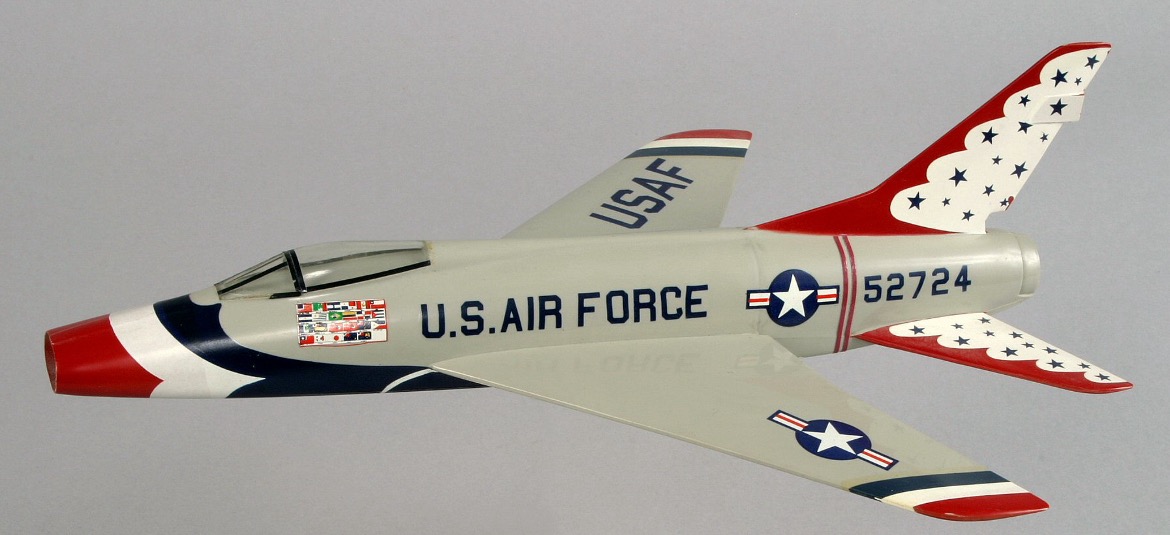USAF Thunderbirds North American F-100C Super Sabre

MODEL BY:
USAF Thunderbirds
Model Scale:
1/48
MODEL ADDED:
05/22/1965
historical significance
First Albuquerque Visit: 1965
Additional Information:
The North American F-100 Super Sabre was a supersonic jet fighter aircraft designed and produced by the aircraft manufacturer North American Aviation. The first of the “Century Series” of American jet fighters, the F-100 was the first United States Air Force (USAF) fighter capable of supersonic speed in level flight. The F-100 was envisioned during late 1940s as a higher-performance successor to the F-86 Sabre air superiority fighter. Initially referred to as the Sabre 45, the F-100 design was delivered to the Air Force in January of 1951. One year later the Air Force ordered two F-100 aircraft prototypes following several modifications to the original design.
The first YF-100A performed its maiden flight on May 25, 1953, seven months ahead of schedule. Flight testing demonstrated both the F-100’s promising performance and several deficiencies that led to numerous fatal accidents. On September 27, 1954, the F-100A officially entered USAF service but was quickly grounded as a result of six major accidents by November of 1954. The F-100 returned to flight in February of 1955 after the investigations and remedial work were completed.
In response to the Air Force’s Tactical Air Command’s (TAC) request for a fighter-bomber, the F-100C was developed, followed by the more capable F-100D. The F-100D was a single-seat fighter-bomber with more advanced avionics, a larger wing, tail fin, and landing flaps. The first flight of the F-100D was on January, 27 1956. A total of 1,274 F-100D models were built. Because of the relatively high attrition rate and the arrival of more advanced fighters, the Air Force decided to permanently withdraw its remaining F-100s from service during the early 1970s. By 1972, the F-100 was mostly phased out of all active Air Force service and turned over to tactical fighter groups and squadrons within the Air National Guard.
The “Thunderbirds” are the air demonstration squadron of the United States Air Force. The Thunderbirds are assigned to the 57th Wing based at Nellis Air Force Base, Nevada. Created in 1953, the Thunderbirds are the third-oldest formal flying aerobatic team using the same name in the world. Number one is the French Air Force Patrouille de France formed in 1931 followed by the United States Navy Blue Angels formed in 1946.
The Thunderbirds became the world’s first supersonic aerial demonstration team when they began using the F-100 Super Sabre in 1956. That same year, the Thunderbirds moved to Nellis Air Force Base, simplifying logistics and maintenance for the aircraft.
The Thunderbirds operated the F-100C from 1956 until 1963 and then after briefly converting to the F-105 Thunderchief, the team flew F-100Ds from July of 1964 until November of 1968, before converting to the F-4E Phantom II.
The Thunderbirds performance was the headliner at the 1965 Armed Forces Day open house at Kirtland Air Force Base in Albuquerque New Mexico using the F-100D. At this time, the Thunderbirds have only made three previous appearances at Kirtland AFB all with the F-100C. The dates of those air shows were August 30, 1957, April 12, 1958, and November 16, 1963. For the May 22, 1965 Armed Forces Day performance at Kirtland, the Thunderbirds used the F-100D.
In response to a request from the Cavalcade of Wings founder Harry Davidson, the Thunderbirds presented the Thunderbird F-100C model currently on display at the Albuquerque Sunport to the ACF Management Club president (L) and Harry Davidson (R) during this event. A letter from the Thunderbirds Information Officer to the Public Affairs office at Kirtland AFB detailing the presentation idea is below along with a photo of the actual model presentation. This model is still on display after almost 60 years.
GALLERY:
SEARCH OUR DATABASE:
